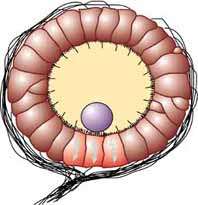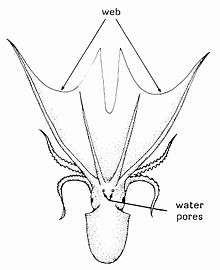Statocyst

The statocyst is a balance sensory receptor present in some aquatic invertebrates, including bivalves,[1] cnidarians,[2] echinoderms,[3] cephalopods,[4] and crustaceans.[5] A similar structure is also found in Xenoturbella.[6] The statocyst consists of a sac-like structure containing a mineralised mass (statolith) and numerous innervated sensory hairs (setae). The statolith's inertia causes it to push against the setae when the animal accelerates. Deflection of setae by the statolith in response to gravity activates neurons, providing feedback to the animal on change in orientation and allowing balance to be maintained.
In other words, the statolith shifts as the animal moves. Any movement large enough to throw the organism off balance causes the statolith to brush against tiny bristles which in turn send a message to the brain to correct its balance.
Statocysts in echinoderms
Because many echinoderms off this group have only simple nervous systems without a controlling "brain", they are limited in their actions and responses to stimuli. The statocyst is therefore useful for telling the animal whether it is upside down or not. An upside-down echinoderm is in danger since its belly is not protected by its spiny skin.
See also
- Accelerometer
- Inertial guidance
- Otolith, an equivalent structure in vertebrates.
- Statocyte, a similar structure in plants
References
- ↑ Morton, B. (2009). "Statocyst structure in the Anomalodesmata (Bivalvia)". Journal of Zoology. 206: 23–34. doi:10.1111/j.1469-7998.1985.tb05633.x.
- ↑ Spangenberg, D. B. (1986). "Statolith formation in Cnidaria: effects of cadmium on Aurelia statoliths". Scanning Electron Microscopy (4): 1609–1618. PMID 11539690.
- ↑ Ehlers, U. (1997). "Ultrastructure of the statocysts in the apodous sea cucumber Leptosynapta inhaerens (Holothuroidea, Echinodermata)". Acta Zoologica. 78: 61–68. doi:10.1111/j.1463-6395.1997.tb01127.x.
- ↑ Clarke, M. R. (2009). "The cephalopod statolithan—introduction to its form". Journal of the Marine Biological Association of the United Kingdom. 58 (3): 701–712. doi:10.1017/S0025315400041345.
- ↑ Cohen, M. J. (1960). "The response patterns of single receptors in the crustacean statocyst". Proceedings of the Royal Society B: Biological Sciences. 152 (946): 30–49. doi:10.1098/rspb.1960.0020.
- ↑ Israelsson, O. (2007). "Ultrastructural aspects of the 'statocyst' of Xenoturbella (Deuterostomia) cast doubt on its function as a georeceptor". Tissue and Cell. 39 (3): 171–177. doi:10.1016/j.tice.2007.03.002. PMID 17434196.


